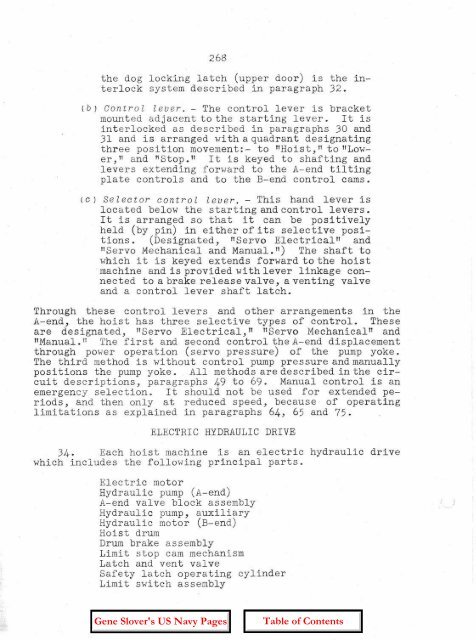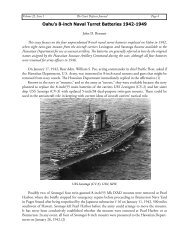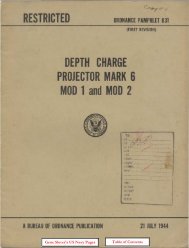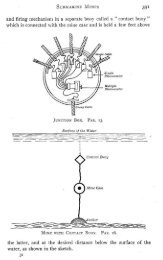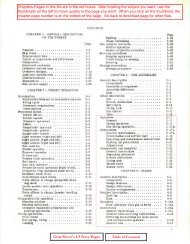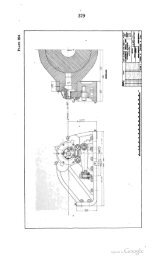OP-755 Part 2 Pages 197-401 - Personal Page of GENE SLOVER
OP-755 Part 2 Pages 197-401 - Personal Page of GENE SLOVER
OP-755 Part 2 Pages 197-401 - Personal Page of GENE SLOVER
You also want an ePaper? Increase the reach of your titles
YUMPU automatically turns print PDFs into web optimized ePapers that Google loves.
268<br />
the dog locking latch (upper door) is the interlock<br />
system described in paragraph 32.<br />
(b) Control lever. - The control lever is bracket<br />
mounted adjacent to the starting lever. It is<br />
interlocked as described in paragraphs 30 and<br />
31 and is arranged with a quadrant designating<br />
three position movement:- to "Ho i st ,IIto IILower,1f<br />
and "Stop.1f It is keyed to shafting and<br />
levers extending forward to the A-end tilting<br />
plate controls and to the B-end control cams.<br />
(C) Selector control lever. - This hand lever is<br />
located below the starting and control levers.<br />
It is arranged so that it can be positively<br />
held (by pin) in either <strong>of</strong> its selective positions.<br />
(Designated, "Se r-vo Electrical!! and<br />
IIServo Mechanical and Manual.!!) The shaft to<br />
which it is keyed extends forward to the hoist<br />
.machine and is provided with lever linkage connected<br />
to a brake release valve, a venting valve<br />
and a control lever shaft latch.<br />
Through these control levers and other arrangements in the<br />
A-end, the hoist has three selective types <strong>of</strong> control. These<br />
are designated, "Se r-vo Electrical," "Ser-vo Mechant caLt' and<br />
"Manual. it The first and second control the A-end displacement<br />
through power operation (servo pressure) <strong>of</strong> the pump yoke.<br />
The third method is without control pump pressure and manually<br />
posi tions the pump yoke. All methods are described in the circuit<br />
descriptions, paragraphs 49 to 69. Manual control is an<br />
emergency selection. It should not be used for extended periods,<br />
and then only at reduced speed, because <strong>of</strong> operating<br />
limitations as explained in paragraphs 64, 65 and 75.<br />
ELECTRICHYDRAULICDRIVE<br />
34 . Each hoist machine is an electric hydraulic drive<br />
which includes the following principal parts.<br />
Electric motor<br />
Hydraulic pump (A-end)<br />
A-end valve block assembly<br />
Hydraulic pump, auxiliary<br />
Hydraulic motor (B-end)<br />
Hoist drum<br />
Drum brake assembly<br />
Limit stop cam mechanism<br />
Latch and vent valve<br />
Safety latch operating cylinder<br />
Limit switch assembly


